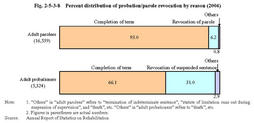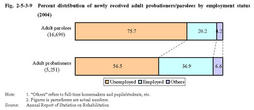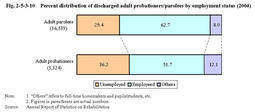| Previous Next Index Image Index Year Selection | |
|
|
5 Measures during supervision and termination of probationary supervision (1) Measures for probationers and parolees with good/bad records For a probationer or parolee whose behavior has become stable and who has come to be considered unlikely to commit repeat offenses during the period of supervision,the following good-conduct measures are implemented:an indeterminate sentence parolee who has served his/her minimum term is granted termination of indeterminate sentence,as if he/she has completed his/her sentence;an adult probationer is granted provisional discharge from probationary supervision.In2004,526probationers(up by8.7%from the previous year)were granted provisional discharge from supervision,while no parolees were granted termination of indeterminate sentence(Source:Annual Report of Statistics on Rehabilitation).
For a probationer of parolee who has violated the conditions of supervision or committed offenses,the following bad-conduct measures are taken.An adult parolee is subject to revocation of parole or revocation of suspension of execution of sentence and is imprisoned in a penal institution,and if an adult parolee is absent from supervision,he/she is subject to suspension of parole and the progress of the sentence is interrupted.In2004,522(down by1.7%(id.))were subject to suspension of parole(Source:Annual Report of Statistics on Rehabilitation). Where a parolee or probationer fails to reside in a fixed abode or there are sufficient reasons to suspect that he/she has violated the conditions of supervision,and he/she fails or would fail to respond when summoned by a probation office director,he/she is apprehended under a warrant of arrest issued by a judge.Following the decision to commence the examination on a bad-conduct measure,he/she is detained in an appropriate institution for a fixed term.In2004,including juveniles,192probationers and parolees(192in2003)were apprehended and161(165in2003)were detained in this manner(Source:Annual Report of Statistics on Rehabilitation). (2) Reasons,etc.for termination of probationary supervision Fig.2-5-3-8 shows the percent distribution of adult probationers/parolees whose probationary supervision terminated in2004by reason.
Examination of their previous offenses for which they were imprison-paroled or put on probation,excluding offenses that less than100probationers or parolees had committed,revealed that the percentage of parole revocation was the highest for larceny(10.5%),followed by Poisonous and Deleterious Substances Control Law violations(7.8%),intrusion upon habitation(7.5%),Stimulants Control Law violations(6.1%),and fraud(6.1%),while the percentage of probation revocation was the highest for intrusion upon habitation(44.0%),followed by larceny(41.4%),fraud(32.7%),injury(27.1%),and Stimulants Control Law violations(26.9%)(Source:Annual Report of Statistics on Rehabilitation). Looking at the percentage of adult parole/probation revocation in2004by employment status at the point of revocation,those unemployed show much higher percentage than those employed(probationary supervision was revoked for15.7%of unemployed parolees and58.3%of unemployed probationers,in contrast,for2.3%of employed parolees and14.7%of employed probationers)(Source:Annual Report of Statistics on Rehabilitation). Fig.2-5-3-8 Percent distribution of probation/parole revocation by reason(2004) Fig.2-5-3-9 and Fig.2-5-3-10 show the percent distribution of adult probationers/parolees newly received and revoked in2004by employment status.Fig.2-5-3-9 Percent distribution of newly received adult probationers/parolees by employment status(2004) Fig.2-5-3-10 Percent distribution of discharged adult probationers/parolees by employment status(2004) |


